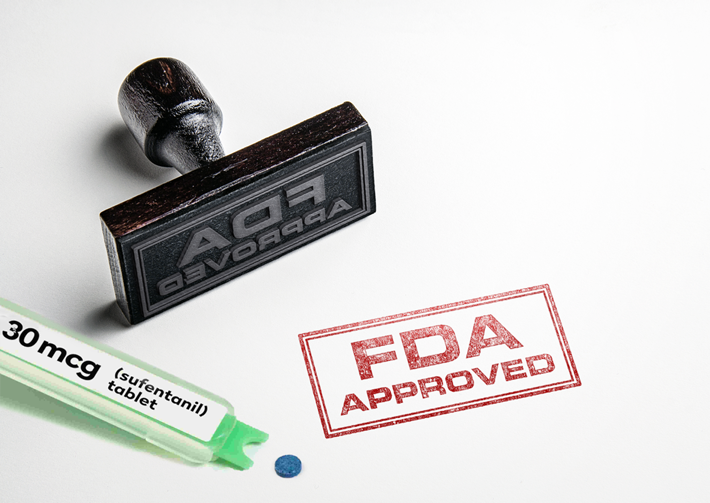Despite Epidemic, the FDA Approves a Powerful New Pain Killer

Jake Harper of NPR.org reported on Nov. 2, 2018 that the FDA has approved the distribution of Dsuvia, [1] a very potent opioid pain reliever. It is 5 to 10 times more potent than fentanyl and 1,000 more potent than morphine. [2] It is a 3-millimeter-wide tablet that is administered under the tongue eliminating the need to find a vein for intravenous administration or to require the patient to swallow a pill. This, they say, addresses the inability to find a viable vein in obese or other patients and for easy stressless administration in severe trauma settings.
The FDA has suggested very strict restrictions on the use of Dsuvia, but strict restrictions have not worked earlier with drugs like Fentanyl or other opiates. The FDA needs more authority and resources to enforce and police their rules. The FDA held an approval committee meeting on 12 October [a vital step in the approval process for any drug], despite the absence of key members (see below).
The Earlier Drug
Fentanyl is a powerful synthetic opiate implicated in the 2016 death of Prince (4) and the 2017 death of Tom Petty. (5) It has recently been named a chief cause in the country’s expanding opioid epidemic. (4)

Fentanyl was approved by the FDA for use as a painkiller and an anesthetic. It is faster and more potent than many other opiates and 50-100 times more potent than morphine and 50 times more potent than many forms of heroin. (4)
Fentanyl was created in 1960 and introduced as an anesthetic in the late 1960s. Since it is synthetic it can be made cheaply and easily in a laboratory. The use of Illegal versions of Fentanyl was named as the leading cause off the tripling the number of deaths from synthetic opioids in just 2 years (3,105 deaths in 2013 and 9,580 deaths in 2015) according to the National Institutes of Health. (4)
Soon the drug cartels learned they could quickly and cheaply manufacture Fentanyl and cut it into the heroin, making it exponentially stronger and more dangerous, and less expensive to produce, leading to more profits for them.
We Should Learn From This Failure
Critics of Dsuvia have reported that the FDA skirted its normal vetting process and feel that Dsuvia is an unnecessary new opioid. They are concerned that with its size and potency it will appeal to people who want to sell and/or misuse it. [1] Dr. Raeford Brown is an anesthesiologist at the University of Kentucky. Dr. Brown chairs the FDA approval committee, but he was not present at the Oct. 12th committee meeting. He had been vocal against the approval of Dsuvia (though he did ultimately approve the drug). He had reported a scheduling conflict several months earlier regarding the 12 October meeting of the approval committee, making him unavailable for the meeting. Despite this information, the meeting was not re-scheduled so that Dr. Brown could attend. It was also noted that the members of the Drug Safety and Risk Management Advisory Committee were not even invited to the October 12th meeting. [1]

Dr. Sidney Wolfe, a senior adviser to Public Citizen’s Health Research Group, dismisses the manufacturer’s claim that Dsuvia meets a crucial need. Along with Dr. Brown, the group sent a letter to the FDA expressing concerns about the drug. “It is not unique at all,” Wolfe says, adding that the drug wasn’t adequately tested in emergency settings, and that in tests, pain relief with Dsuvia was slow, according to two of the company’s studies, These studies, which you can read by following the link, are written by the company that stands to make billions once the drug is approved and made available for sale to hospitals. According to their own studies, Dsuvia patients only felt “meaningful” pain relief at 54 minutes and 78 minutes. Considering the small size of the pill and the fact that it is intended to address and alleviate severe pain, the opportunities for overdose while waiting the 54 or 73 minutes for the drug to start working are exponentially increased. It should be noted that the manufacturer AcelRx projects $1.1 billion in annual sales and is hoping to have the drug in hospitals by early next year. [1]
The Department of Defense supported and helped fund the development of this drug with the intention to administer it on the battlefield. This would expose our wounded combat soldiers to addiction, overdose, or further injury should the wounded drugged soldier decide to continue fighting despite this his injury.
At this point, we need to ensure that Congress appropriates the funds to the FDA and the DEA so they can closely control the use of this drug and all drugs and medicines and enforce their rules and laws regarding opiate use and dispensation. With the company projecting billions in annual sales, Congress needs to act to ensure the company is contributing to keeping us safe and helping to decrease rather than increase the opioid problem.
References:
- 1. https://www.nytimes.com/2018/11/02/health/dsuvia-fda-opoid.html
- 2. https://www.webmd.com/pain-management/news/20181102/fda-oks-powerful-new-opioid-despite-criticisms#2
- 3. https://www.npr.org/sections/health-shots/2018/11/02/663395669/despite-warnings-fda-approves-potent-new-opioid-painkill
- 4. https://www.webmd.com/mental-health/addiction/news/20180501/fentanyl-what-you-should-know
- 5. https://www.rollingstone.com/music/music-news/tom-pettys-cause-of-death-accidental-overdose-202789/


 ®
®